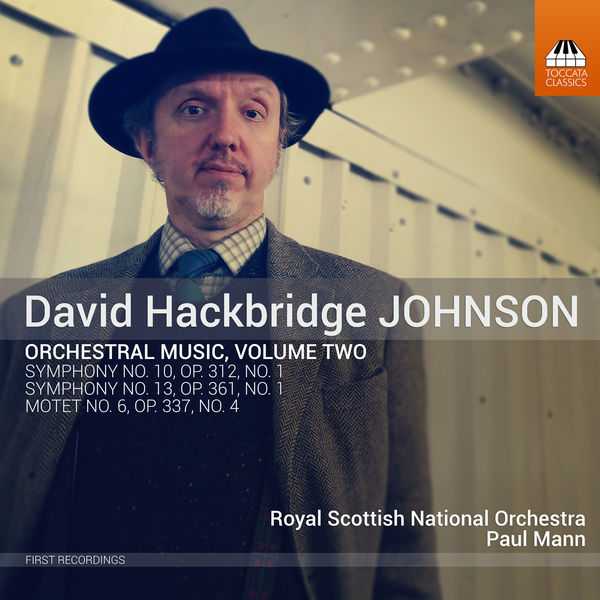

Composer: David Hackbridge Johnson
Orchestra: Royal Scottish National Orchestra
Conductor: Paul Mann
Format: FLAC (tracks)
Label: Toccata
Catalogue: TOCC0452
Release: 2018
Size: 1.42 GB
Recovery: +3%
Scan: yes
Symphony No. 10, Op. 312 No. 1
01. I. Preludio tragico: Molto moderato
02. II. Marche funèbre: Lento
03. III. Scherzo spettrale: Presto
04. IV. Epilogue: Mesto
05. Motet No. 6, “Benedicite Maria et Flumina”, Op. 337, No. 4
Symphony No. 13, Op. 361 No. 1
06. I. Allegro con brio
07. II. Poco lento
08. III. Allegro alla burlesca
The orchestral music of the English composer David Hackbridge Johnson (b. 1963) is one of the most important discoveries to have been made by Toccata Classics. This second volume brings two mighty symphonies: the dark and tragic No. 10 (2013), cast in a single monumental span, and the three-movement No. 13 (2017), a fierce and fiery affirmation of life. They are complemented here by an orchestral ‘motet’ which passes plainchant in kaleidoscopic review. Writing in Gramophone, Guy Rickards said of Hackbridge Johnson’s Ninth Symphony: ‘what is so astonishing is not his ambition in attempting such large, big boned structures […] but that he possesses the compositional technique to achieve them so completely. […] This is a profound, complex and visionary utterance’.
The appearance in 2017 of the first volume of the music of David Hackbridge Johnson on Toccata Classics took many by surprise, not only because he has written a vast body of work in relative secrecy since his childhood, but also because the quality of his music is nothing short of extraordinary for a nearly unknown output. Paul Mann leads the Royal Scottish National Orchestra for this second volume, continuing the revelations of Johnson’s long-hidden art, and the listener may notice Johnson’s many influences, which include Mahler, Nielsen, Sibelius, Shostakovich, and especially Vaughan Williams, to name just a few symphonists whose ideas resonate in the Symphony No. 10, Op. 312, No. 1 and the Symphony No. 13, Op. 361, No. 1. Johnson doesn’t slavishly imitate anyone, but he has internalized the music of his predecessors and personalized the rhetorical style and formal organization of the modern symphony to suit his expansive vision. Somewhat more idiosyncratic are Johnson’s shorter orchestral motets and anthems, of which the Motet No. 6, Benedicite maria et flumina, Op. 337, No. 4 is a good example. The subdued character and flowing lines of this reflective piece offer a contrast to the dramatic character of the symphonies, though one could easily imagine the motet as one of Johnson’s slow movements. Mann’s interpretations are confident and convincing, and the orchestra delivers the music with precision and great energy, making the case for Johnson’s music without any received tradition to fall back on.



